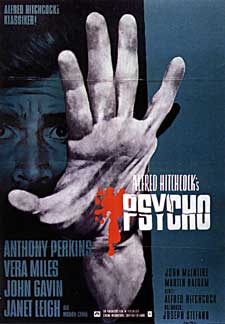
Film AnalysisThe Birds
otherwise known as:
"The Wild City Woman Who Had To Be Tamed Through
Adversity"
"The Games People Play"
"When Animals Fight Back"
"The Family That Had to be Set Right"
"Appearances Are Deceiving or Things Are Not As They Seem"
"Home Attack"
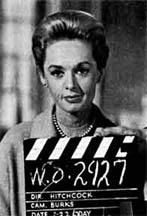
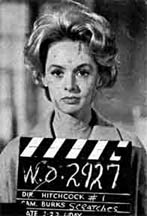
Pre-Production:
Hitchcock was meticulous ( "scholarly
attention to the physical world") about preparation of the sets and
costumes. He would have people research characters by meeting with an
actual secretary for a real-estate agent in Phoenix, as in Psycho,
and take photos and notes about everything from her bureaus drawers' contents
to the pictures on the wall in her apartment.
For The Birds he had every person who lived in the real Bodega
Bay photographed for the costume department. The restaurant is an exact
copy of the one there.
"As a draughts man, a Roman Catholic, a gourmand, and a punctilious
man of habit, Hitchcock was a ritual formalist who explored psychology
not by encouraging his actors to implode in emotional freefall but by
containing them within social convention, defined by his strict pictorial
frame".
Special Effects:
- For the chaotic fireplace scene: "on
set, the room was wrapped in polyethylene plastic, which transmitted light
but trapped the frantic birds as they were tossed about by air hoses.
Quadruple superimpositions were later made".
- For the footage of birds swooping: "A camera crew took over 20,000
feet of film over three days at the San Francisco dump, where they raked
garbage into a pile to lure seagulls to dive, perch, and feed".
- "The crow attack on the schoolhouse contained sixty cuts and required
six weeks to assemble".
- For the final attic scene: "Seven days were needed for shooting
this horrifying sequence, which takes only two minutes and ten seconds
on screen. Hedren called it the worst week of her life. A cage built around
the set contained the birds which were literally thrown at her from a
distance of eight to ten feet by prop men wearing padded gloves".
The shooting halted for a week after that at the orders of Hedron's doctor.
Audio:
The film has no score; all nondiegetic
(not natural to the scene) sounds are bird noises, enhanced with a Trautonium,
an electronic atonal keyboard. The minimilsm of the audio enhances the
banality of the site of terror in the film: these are common, everyday,
"natural" sounds, yet horrible disturbing things are happening
to them, just as the birds attacking upsets the normalcy of Bodega Bay
and the Brenner family.
The Irrationality,
The Terror:
Melanie's arrival in Bodega Bay seems to
bring on the bird attacks. They are a sort of terrorism; it defies rationality...
birds of different species flocking together. Killing women and attacking
children, infiltrating your home, which is supposed to be a safe space.
Gender
Roles:
Lydia is an older Melanie, but wound up
so tight that she requires the horror of seeing Dan Fawcett's corpse to
begin to shake her out of it. Propelled into the role of 'caring mother',
she fulfills Melanie's own mother-lack. But only through facing the abyss,
the horror of nature run amok, the pervasive terrorizing of their familiar,
domestic world, can their repressions and stoic natures, fears of being
without a man, abate and real compassion emerge, and the honesty to reach
out when in need. The home, the site of safety full of memories of Lydia's
dead husband, is the place of retreat and the place of imminent invasion.
Annie, as the double of Melanie, must be sacrificed for the correct nuclear
family to be intact; no 'other woman' to compete with for the man's/Mitch's
attention can be tolerated. Melanie's past sins against her proscribed
role in proper society are forgiven, and she is redeemed by surviving
her given ordeal, her test. By emerging as a grateful daughter with Lydia
becoming her mother, filling in the absence she's lived with for so long.
Lydia finally becomes compassionate and warm because of the ordeal, and
is able to recognize Melanie's need for nurture. The status quo family
is intact at the end, but we are left with an unsure ambiguous view of
their future.
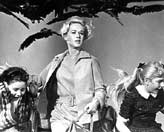
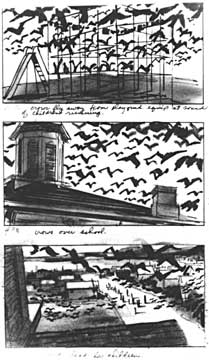
- depending on class time, try to show about 25 minutes per day.
- have new board notes and required journal entries daily.
- review what was watched the previous day, as well as anecdotes and board notes, before viewing more.
It is very important that the film be watched in segments that can be discussed before more of the film is watched. This is a method that has been extremely successful for me: it allows you to model for the students how they can be watching the film in terms of critical thinking skills, what sort of questions they can be asking in terms of exploring motivations and character development, and allows you to revisit the narrative of the film so that everyone is on the same page.
The first thing students do as they enter the room on the second day of viewing, is to copy down the new board notes. These consist of "themes", "vocabulary", information about historical events of the time the film was made, and the names of the main characters. This is important journal-writing for reflection and allows the opportunity to build upon the review and reflection process, encouraging students to add their own notations and opinions.
Then they need to write in their journal their version of the narrative up to that point. As opposed to taking away from the "entertainment" value of a film, this process actually has turned out to build keen excitement and suspense in my students as they revisit the previously viewed segment and await the next bit of the film to view.
Give students enough time for that, then lead a discussion by asking someone to describe what's happened so far. Allow others to interject plot points. As points of importance arise, it is your opportunity to stress certain themes and metaphors, saying things like, "notice that.....", or "what do you think that means...". This is also the time to connect what students remember to the themes you've written on the board. Drive the discussion with leading questions and encourage new insights to arise. Tie items in the film to the real-life historical events you've mentioned on the board.
Excitement is now built for further viewing, you're modelling how to watch a film critically, and you're striking memory chords so that the film will continue to make sense after a delay in viewing.
